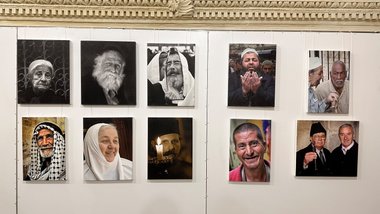Odyssey of the “Wild Priest”
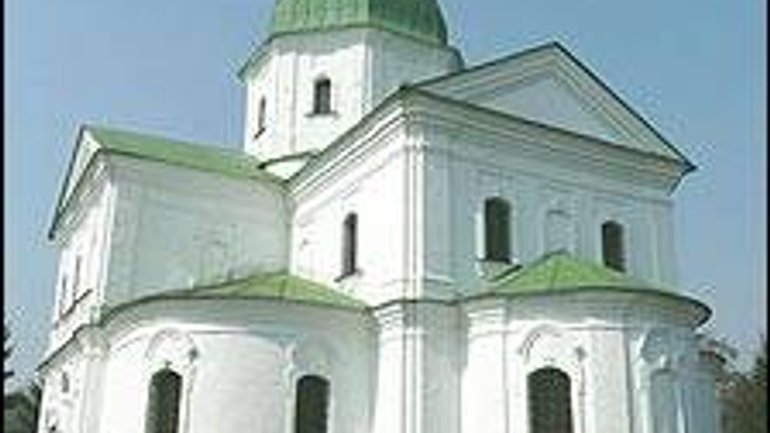
The old town of Kozelets in northern Ukraine’s Chernihiv Region never stood out for having a big population. Its population was only 3000 inhabitants at the end of the 18th century, and just barely reached four and a half thousand before the revolution of 1917. Nonetheless, unique individuals have always appeared here, in all eras and under all rulers. “This is fate” will sigh the affected reader. “And the road,” we’ll add.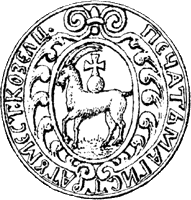
The road, that very legendary route, Kyiv-St. Petersburg, is the main interest point of Kozelets. We won’t go into listing documented evidence, but take our word for it – all the highlights from this history are in one way or another connected to this ancient trodden route. Thanks to this route, people became “somebodies” – obviously, not everyone, but periodically the road brought somebody real luck. Among the lucky townsfolk we find all sorts of people, sometimes really outstanding individuals. Our hero, in his long and tumultuous life, knew how to use his power to gain good words in his favor from the mouths of his contemporaries and also successive generations. This extraordinary individual was named Kyrylo Mykolaiovych Tarlovskii, although he has come down in history with the comedic nickname “wild priest.”
It all began in the distant 16th century… At that time almost all of Ukraine belonged to the Polish crown. Thousands of Poles moved eastward in search of happiness, fortune and fame. In 1587, the long trailblazer Tarach-Tarlovskii rode on this same wave of migration from Mazowia to Kyiv. Tarlovskii gained some education in Kyiv, then moved to Kozelets, married a town noblewoman and settled down to a peaceful life in his new homeland. After three or four generations the Tarach-Tarlovskiis (who came to be known only as Tarlovskii) converted to Orthodox Christianity and formed a true dynasty of Kozelets priests, which continued until the end of the 19th century.
Sometime near the beginning of the 1700s, the pastor of the humble wooden St. Nicholas Church in Kozelets, Fr. Mykola Tarlovskii, and his wife Anna had a son and named him Kyrylo. In the following years the career of the young priest’s son followed a standard course and promised nothing out of the ordinary: studies at the Kyiv Academy, priestly ordination, service in the church of the Kozelets’ women’s monastery, and, after the death of his father, “the inherited” St. Nicholas Parish.
The year 1744 brought the turning point in the destiny of the provincial priest. While accompanying Count Razumovsky and his court on a trip, Empress Elizabeth, daughter of Peter the Great, decided to visit the native places of her minions. Obviously, Kozelets stood out as a special point in her route, a place to which a great many Razumovskys had already departed, leaving their villages and farmsteads.
Elizabeth, as it went, visited town churches. Today, looking at the beauty of the town’s churches with many cupolas, it is hard to even imagine what “hole” the monarch was forced to look upon. All the architectural wonders that exist now appeared here much later, and in 1744, of the five Kozelets’ churches, only one — the Church of the Transfiguration—was made of brick. Today it would look more than humble against the backdrop of the magnificent Church of the Nativity of the Virgin Mary, but the Bolshevik cultural revolution has destroyed our chance for comparison—the oldest brick church in Kozelets was disassembled in the 1920s to use for bricks.
In other words, there weren’t any visible reasons for the ruler of a superpower to turn her attention to a simple provincial priest.
Traditionally these lacunae in history are filled in with legends. According to one of these legends, at a prayer service at one of the royal palaces on the banks of the Oster River, Elizabeth and Alexis Razumovsky were secretly married and the rite performed by our very own Fr. Kyrylo. Even experts approach this version with more conviction than skepticism. Either way, Tarlovskii had obviously performed some great favor for someone from the myriad of rulers, or else he had simply stood out from the masses and caught the “right” eye.
Otherwise it is difficult to explain why an average Kozelets priest (not even a cathedral pastor) traveled with the monarch’s delegation all the way to St. Petersburg. And in the capital a glamorous future awaited him: the status of priestly minister in the Household Troops Company building, which led directly to the circles of influential courtside officers.
(Note: The Household Troops Company was the grenadier company (364 people) of the household troops Preobrazhensky Regiment, through whom Elizabeth carried out a government coup on 25 November 1741. From then on the household troops were transformed into a kind of regiment within a regiment and performed the function of the military company most attached and loyal to the princess. It was stationed next to the Winter Palace, which it defended. Peter III disbanded the company, but after some time Catherine II renewed it, in fact, effectively destroying her own status.)
On top of all of this, there are rumors that Kyrylo Mykolaiovych was the personal spiritual advisor to Princess Catherine —the future Empress Catherine II. In two decades of Petersburg life, Tarlovskii made many important contacts. Among these, the wisest (as later would become clear) became his friendship with the young administrator and hopeful literary man Vasyl Chertkov. Out of hundreds of Tarlovskii’s acquaintances, only Chertkov proved to be his one and only true friend.
After Elizabeth’s death, clouds began to gather over Fr. Kyrylo’s head. The brothers Alexis and Kyrylo Razymovsky immediately reacted coldly to the new emperor, Peter III, a transitional figure on the throne. Then, the majority of promoted and recommended earls of Kozelets seized the moment to support the monarch-hemophiliac. In the end, this cost many, many people their careers.
Having fallen into a similar situation, and for some reason (unknown to us now), having fought for his life, Tarlovskii decided to flee right after Catherine’s forceful rise to power in 1762. Just in the nick of time he had also acquired for himself a passport from the synod with permission to freely live and serve in “Little Russia” (Ukraine). He didn’t waste a moment.
Only once he was in Ukraine, 1000 miles away from the capital, did the runaway let his guard down. He didn’t even make use of his universal passport. The former courtside priest was in constant fear and spent his days and nights at the mills of the monastery near Kyiv, praying to God that he would remain anonymous. However, soon after, a heightened sense of danger (or a constant state of nervousness and the illusion of this feeling) pushed him further. Our hero chose an unprecedented step for himself and left civilization for the freedom of the steppes of southeastern Ukrainian Zaporizhzhia.
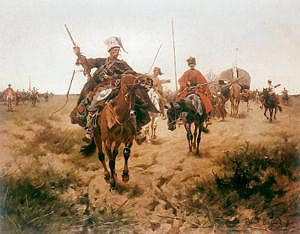 For a long time Tarlovskii wandered the wild steppes somewhere in the present-day territory of the Dnipropetrovsk Region. He fed on wild fruits and slept on the bare earth, covering himself only in torn vestments. The organism of a person worn down with age and the hardships of life didn’t allow him to withstand that kind of lifestyle for long and demanded a breather from the never-ending Robinson-Crusoe style of existence. During one of these pauses somewhere in a remote gully Fr. Kyrylo tried to start a fire to prepare himself a humble meal. Suddenly, armed and mounted men appeared at the source of the smoke—they were the Cossack defense. Knowing that he no longer had anything to lose, the fugitive began to speak to the unexpected guests, inviting them to dinner.
For a long time Tarlovskii wandered the wild steppes somewhere in the present-day territory of the Dnipropetrovsk Region. He fed on wild fruits and slept on the bare earth, covering himself only in torn vestments. The organism of a person worn down with age and the hardships of life didn’t allow him to withstand that kind of lifestyle for long and demanded a breather from the never-ending Robinson-Crusoe style of existence. During one of these pauses somewhere in a remote gully Fr. Kyrylo tried to start a fire to prepare himself a humble meal. Suddenly, armed and mounted men appeared at the source of the smoke—they were the Cossack defense. Knowing that he no longer had anything to lose, the fugitive began to speak to the unexpected guests, inviting them to dinner.
The conversation eventually touched upon spiritual matters. Cossacks, with all the freedom of their customs, approached questions of faith with a high degree of respect and called themselves the defenders of Orthodoxy, although they couldn’t possibly know fine points of theology. Only imagine their shock when a dirty savage-looking “bum,” of which there were hundreds roaming the steppes, suddenly began explaining in complex and sharp terms and quoting from the holy Bible, recalling the beautiful city of St. Petersburg, a city they had never seen… In the morning, without any superfluous speech they sat this unusual character on a horse and took off for the Sich.
The official position of Tarlovskii at that moment was left openly vague. He himself was positively frightened of everything and didn’t even try to come into contact with any power structures, counting on simply sitting out the storm on the sea of life. On the other hand, no one was formally searching for Kyrylo Mykolaiovych, so perhaps it was harmless for him to communicate with any subordinate of the Russian Empire.
And so it happened that our hero, willingly or unwillingly, was “appointed” pastor of the Sich Church of the Protection of the Mother of God. According to an old Cossack custom in memory of the strange theological dispute in the wild steppe they eternally labeled him with the name “wild priest.”
According to information from a number of sources, Tarlovskii didn’t serve long in this new post. Obviously, up until then he hadn’t risked legalizing himself, especially since he was living in the company of the freedom-loving Zaporizhzhia brotherhood. Still, the “wild priest” no longer left the borders of the Zaporizhzhia territory. He rode from settlement to settlement, taking care of the spiritual needs of the local inhabitants. Somewhere around there Tarlovskii took part in an unbelievable encounter with a delegation from Yemelyan Pugachev, which painstakingly questioned the witness of the coup d’etat of 1762 about the fate of Peter III.
In 1775, according to royal decree, the Sich was liquidated. Huge uninhabited expanses of land in the south of the empire, which used to play a buffer role between the Orthodox Christian and Islamic worlds, now were liable to be colonized and settled. A titanic volume of planned changes called for people with energy, initiative, and creative thinking to sign on with the colonization projects. From distant St. Petersburg scores of monarchical decrees were sent out about the appointment of a new echelon of administration. In the first number of nominees there appeared Kyrylo’s good friend from the capital, and, from now on, the fully respected governor of Azov, Vasyl Chertkov.
Having found out about the misfortune of his old friend, the dignitary turned to Catherine, recommending Fr. Kyrylo in the best light. There was certainly also a practical side to Chertkov’s recommendation—to look for qualified, experienced executors in a foreign land is always difficult. Tarlovskii knew the area very well, easily found a common language with the people of Zaporizhzhia and readily embraced colonization and educational developments.
The empress didn’t turn down Chertkov’s request. The past sins of the “wild priest” were forgiven and his title was restored to “household troops priest.” He was sent to the ranks of the active army in time for the Russian-Turkish (Crimean) war. It is known that Tarlovskii spent time with the Russian divisions in Crimea. Other than that, Kyrylo Mykolaiovych received 25,000 desiatynas [1 desiatyna = 2.7 acres] of the former wild steppes for his own use.
Only then did the true golden age of the “wild priest” begin. Forgetting about his age, the 70-year-old priest spent day and night wandering the steppes, fully given in to a new endeavor. Under his watchful eye 24 existing villages were established; 12 churches with medical clinics and schools were built with his funds. In the village of Novoselytsi (on the site of modern day Novomoskovska) and in the neighboring village of Orlovshchyni the “wild priest” established church and singing schools.
And inasmuch as people came to settle the steppes with hardly anything, “straight from the road,” he used his own funds to build them buildings. He allotted each family a pair of oxen, a horse, and nine sheep and homestead supplies. At the same time Tarlovskii used his power of eloquent speech to convince others to follow his lead.
He made his main residency in the village of Voskresenivky, where he often stayed when he was still a fugitive and now as an accepted official settled with people from his native Kozelets. Among the last of these settlers were his brother and three nephews. They say that up until the 20th century you could still see his building in Voskresynivky. It was made according to his own design. For quick escape in the face of danger you could exit the building quickly through any of the four exits.
At the end of the legendary “wild priest’s” life, an idea came into his head to immortalize his difficult life journey in the image of two stone churches. Both buildings, judging from it all, appeared simultaneously and both were dedicated to St. Nicholas the Miracle-worker. The first church was built with money from Tarlovskii’s countrymen in Kozelets. The old wooden church where Kyrylo Mykolaiovych had started his unbelievable career had burned down in 1752. At the time, the priest had helped the victims of the fire from his position in the capital as much as he could: he sent money and gave recommendations. This record was preserved in the town community for more than 100 years, until a meticulous mayor glued the old, sturdy pieces of already unintelligible paper to the walls of one of the community lodgings.
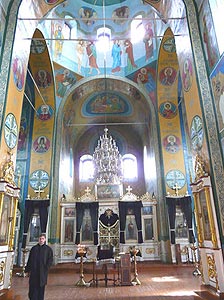 Between the years of 1781-1784 the sides of the old burned buildings were used to construct a new tall church with a steep, rocket-like cupola. It stands there even today, beautiful and cared for, although the Liturgy isn’t celebrated there often—all the simple needs of the townspeople are taken care of by the huge two-storied Church of the Nativity of the Virgin Mary. The Nicholas Church was the first stone religious building in Kozelets. It was given back to the faithful in the Gorbachev era (up until then it had served as a storage place).
Between the years of 1781-1784 the sides of the old burned buildings were used to construct a new tall church with a steep, rocket-like cupola. It stands there even today, beautiful and cared for, although the Liturgy isn’t celebrated there often—all the simple needs of the townspeople are taken care of by the huge two-storied Church of the Nativity of the Virgin Mary. The Nicholas Church was the first stone religious building in Kozelets. It was given back to the faithful in the Gorbachev era (up until then it had served as a storage place).
Unfortunately, as it goes, people tried a bit too hard, and the once stylish white-as-snow interior walls of the Ukrainian-baroque temple are now covered with “canonical” oil painting. The lovely old gentleman who opened the church doors for us was really pleased with “this creation,” so I couldn’t bring myself to tell him the truth—what pleased my eye, and what really didn’t. Today, in the yard surrounding St. Nicholas’ Church you can find the main residence of the head town priest, of the Moscow Patriarchate.
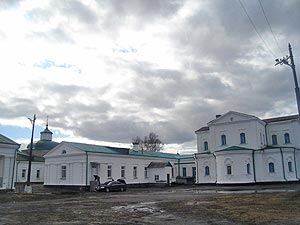 The second temple Tarlovskyi built where he completed his long life’s odyssey. On the banks of the Samar River, near Novomoskovsk, in an ancient Cossack monastery, there had long stood the wooden Cathedral of St. Nicholas. Kyrylo Mykolaiovych was a regular benefactor of this church and in the 1780’s on the site of the old cathedral he built a new one—judging from the pictures, identical to the Kozelets one.
The second temple Tarlovskyi built where he completed his long life’s odyssey. On the banks of the Samar River, near Novomoskovsk, in an ancient Cossack monastery, there had long stood the wooden Cathedral of St. Nicholas. Kyrylo Mykolaiovych was a regular benefactor of this church and in the 1780’s on the site of the old cathedral he built a new one—judging from the pictures, identical to the Kozelets one.
On 7 March 1787, at the blessing of the church “the wild priest” gave the monastery’s superior, Priest-monk Feofan, 4000 rubles for prayers for the souls of individuals who quite plainly had been close acquaintances of Kyrylo. The former court priest asked the monks to pray for the eternal repose of the ottoman of the Zaporizhzhia Army, Yakov Sidlovskii, and for the health of the head of the rebel villagers, Semen Harkush, who was sentenced to life imprisonment in Siberia. For himself, Tarlovskii built a separate place not far away and there he died and was buried not too long after.
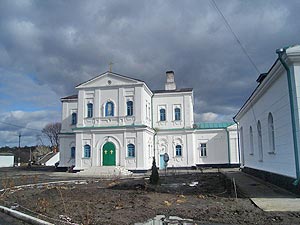 According to andy_babubudu.livejournal.com, during socialist times they built a building here for old people and the mentally ill. In 1993, in the monastery’s buildings the parish was reborn, and after two years a women’s monastery formed. On 12 March 1998, the Holy Synod of the Ukrainian Orthodox Church-Moscow Patriarchate transformed St. Nicholas, the Samar hermit women’s monastery, and St. Nicholas Parish in Novomoskovsk into a men’s monastery.
According to andy_babubudu.livejournal.com, during socialist times they built a building here for old people and the mentally ill. In 1993, in the monastery’s buildings the parish was reborn, and after two years a women’s monastery formed. On 12 March 1998, the Holy Synod of the Ukrainian Orthodox Church-Moscow Patriarchate transformed St. Nicholas, the Samar hermit women’s monastery, and St. Nicholas Parish in Novomoskovsk into a men’s monastery.
However, today you can’t find the place where Tarlovskii was buried—it disappeared sometime in the 19th century. Even Dmytro Yavornytskii, the author of the classic essay on the individual known as the “wild priest,” didn’t know where exactly the burial mound is located.
The one and only image made of Kyrylo Mykolaiovych Tarlovskii was made at least two times and was preserved in the sacristies of both St. Nicholas churches, in Kozelets and Samar. The first portrait was part of a museum collection in 1897 of the Chernihiv Region archival commission, where it is now is unknown. Perhaps it doesn’t exist anymore.
The second image survived, surprisingly, and today is preserved in the collection of the D. I. Yavornytskiy historical museum in Dnipropetrovsk. In the painting, “the wild priest” is depicted in a green cassock and brown under-frock, standing near an open window behind which you can see a church. Tarlovskii is pressing his right hand to his heart as his left hand rests on the Gospel.
Below the figure is the caption:
“A portrait of Father Kyrylo Tarlovskii,
whose generosity built this church.”
Translated by Bozena HRYCYNA.
RISU’s Ukrainian-language site posted the original on 29 August 2008.








